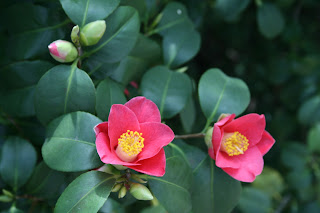Camellias in Europe
In early April 2009, I went with my husband to Dresden, a place I had long wanted to visit, and we took a side trip to the nearby Schloss Pillnitz. Schloss Pillnitz has extensive gardens and two great glasshouses, and it was the second of these that I particularly wanted to see.
Camellias were first brought to Europe in the seventeenth century from Asia. Legend has it that the Pillnitz camellia was brought from Japan by Carl Peter Thunberg, along with three others, one of which was given to Kew Gardens. However, sadly, this story is now considered doubtful. Sadly, because that would mean none of these camellias survived. However, the Pillnitz camellia was certainly planted at Pillnitz in 1801 by the gardener Carl Adolph Terscheck, in the soil where it is still growing.
Camellias were initially considered to be tender plants. We know now that they can survive some frosts (like the one in my garden), and their RHS rating is H5, which means it is hardy down to -10C, though best in a sheltered site. At Pillnitz, temperatures went down much below that.
In any case, even in England, glazed camellia houses were built for the prized new acquisitions. I first discovered camellias when I wandered, dog on lead, as a teenager into the camellia house at Wollaton Park near my home, and was blown over by their beauty. They certainly look fragile.
So a house was built for the Pillnitz plant, and in winter it was wrapped up with straw and bast matting. A hundred odd years later, in 1905, the camellia house was accidentally overheated and burst into flames. The fire was extinguished, but as it was -20C outside, the water froze solid around the plant. The gardeners must have been in despair, but, staggeringly, the camellia survived inside the ice and flowered the following spring.
In 1992, a new protective house was built for the huge shrub. It weights 54 tonnes and is 13.2 metres high. Its structure protects the place between October and May, and gets moved away on runners for the summer months.
The Pillnitz camellia may not have been brought to Europe by Thunberg, but records do show that it arrived at the court of the King of Saxony between 1770 and 1790, and it is the oldest camellia north of the Alps. It is also beautiful, a lovely shade of cerise, with shapely, single flowers. I am so happy to have seen it, and it's a pleasure to revisit it now.




No comments:
Post a Comment
Note: only a member of this blog may post a comment.